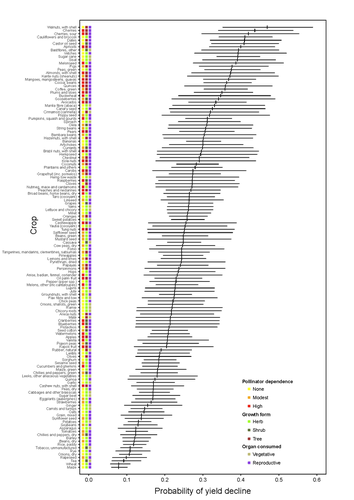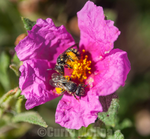
DEGUINES Nicolas
- Laboratoire EBI UMR 7267, Université de Poitiers, Poitiers, France
- Agroecology, Biodiversity, Climate change, Community ecology, Conservation biology, Food webs, Interaction networks, Landscape ecology, Macroecology, Pollination, Terrestrial ecology
Recommendations: 0
Reviews: 2
Reviews: 2

Being a tree crop increases the odds of experiencing yield declines irrespective of pollinator dependence
The complexities of understanding why yield is declining
Recommended by Ignasi Bartomeus based on reviews by Nicolas Deguines and 1 anonymous reviewerDespite the repeated mantra that "correlation does not imply causation", ecological studies not amenable to experimental settings often rely on correlational patterns to infer the causes of observed patterns. In this context, it's of paramount importance to build a plausible hypothesis and take into account potential confounding factors. The paper by Aizen and collaborators (2023) is a beautiful example of how properly unveil the complexities of an intriguing pattern: The decline in yield of some crops over the last few decades. This is an outstanding question to solve given the need to feed a growing population without destroying the environment, for example by increasing the area under cultivation. Previous studies suggested that pollinator-dependent crops were more susceptible to suffering yield declines than non-pollinator-dependent crops (Garibaldi et al 2011). Given the actual population declines of some pollinators, especially in agricultural areas, this correlative evidence was quite appealing to be interpreted as a causal effect. However, as elegantly shown by Aizen and colleagues in this paper, this first analysis did not account for other alternative explanations, such as the effect of climate change on other plant life-history traits correlated with pollinator dependence. Plant life-history traits do not vary independently. For example, trees are more likely to be pollinator-dependent than herbs (Lanuza et al 2023), which can be an important confounding factor in the analysis. With an elegant analysis and an impressive global dataset, this paper shows that the declining trend in the yield of some crops is most likely associated with their life form than with their dependence on pollinators. This does not imply that pollinators are not important for crop yield, but that the decline in their populations is not leaving a clear imprint in the global yield production trends once accounted for the technological and agronomic improvements. All in all, this paper makes a key contribution to food security by elucidating the factors beyond declining yield trends, and is a brave example of how science can self-correct itself as new knowledge emerges.
References
Aizen, M.A., Gleiser, G., Kitzberger T. and Milla R. 2023. Being A Tree Crop Increases the Odds of Experiencing Yield Declines Irrespective of Pollinator Dependence. bioRxiv, 2023.04.27.538617, ver 2, peer-reviewed and recommended by PCI Ecology. https://doi.org/10.1101/2023.04.27.538617
Lanuza, J.B., Rader, R., Stavert, J., Kendall, L.K., Saunders, M.E. and Bartomeus, I. 2023. Covariation among reproductive traits in flowering plants shapes their interactions with pollinators. Functional Ecology 37: 2072-2084. https://doi.org/10.1111/1365-2435.14340
Garibaldi, L.A., Aizen, M.A., Klein, A.M., Cunningham, S.A. and Harder, L.D. 2011. Global growth and stability of agricultural yield decrease with pollinator dependence. Proceedings of the National Academy of Sciences, 108: 5909-5914. https://doi.org/10.1073/pnas.1012431108

Niche complementarity among pollinators increases community-level plant reproductive success
Improving our knowledge of species interaction networks
Recommended by Cédric Gaucherel based on reviews by Michael Lattorff, Nicolas Deguines and 3 anonymous reviewersEcosystems shelter a huge number of species, continuously interacting. Each species interact in various ways, with trophic interactions, but also non-trophic interactions, not mentioning the abiotic and anthropogenic interactions. In particular, pollination, competition, facilitation, parasitism and many other interaction types are simultaneously present at the same place in terrestrial ecosystems [1-2]. For this reason, we need today to improve our understanding of such complex interaction networks to later anticipate their responses. This program is a huge challenge facing ecologists and they today join their forces among experimentalists, theoreticians and modelers. While some of us struggle in theoretical and modeling dimensions [3-4], some others perform brilliant works to observe and/or experiment on the same ecological objects [5-6]. In this nice study [6], Magrach et al. succeed in studying relatively large plant-pollinator interaction networks in the field, in Mediterranean ecosystems. For the first time to my knowledge, they study community-wide interactions instead of traditional and easier accessible pairwise interactions. On the basis of a statistically relevant survey, they focus on plant reproductive success and on the role of pollinator interactions in such a success. A more reductionist approach based on simpler pairwise interactions between plants and pollinators would not be able to highlight the interaction network structure (the topology) possibly impacting its responses [1,5], among which the reproductive success of some (plant) species. Yet, such a network analysis requires a fine control of probable biases, as those linked to size or autocorrelation between data of various sites. Here, Magrach et al. did a nice work in capturing rigorously the structures and trends behind this community-wide functioning. To grasp possible relationships between plant and pollinator species is a first mandatory step, but the next critical step requires understanding processes hidden behind such relationships. Here, the authors succeed to reach this step too, by starting interpreting the processes at stake in their studied plant-pollinator networks [7]. In particular, the niche complementarity has been demonstrated to play a determinant role in the plant reproductive success, and has a positive impact on it [6]. When will we be able to detect a community-wise process? This is one of my team’s objectives, and we developed new kind of models with this aim. Also, authors focus here on plant-pollinator network, but the next step might be to gather every kind of interactions into a huge ecosystem network which we call the socio-ecosystemic graph [4]. Indeed, why to limit our view to certain interactions only? It will take time to grasp the whole interaction network an ecosystem is sheltering, but this should be our next challenge. And this paper of Magrach et al. [6] is a first fascinating step in this direction. **References** [1] Campbell, C., Yang, S., Albert, R., and Shea, K. (2011). A network model for plant–pollinator community assembly. Proceedings of the National Academy of Sciences, 108(1), 197-202. doi: [10.1073/pnas.1008204108](https://dx.doi.org/10.1073/pnas.1008204108) [2] Kéfi, S., Miele, V., Wieters, E. A., Navarrete, S. A., and Berlow, E. L. (2016). How structured is the entangled bank? The surprisingly simple organization of multiplex ecological networks leads to increased persistence and resilience. PLoS biology, 14(8), e1002527. doi: [10.1371/journal.pbio.1002527](https://dx.doi.org/10.1371/journal.pbio.1002527) [3] Gaucherel, C. (2019). The Languages of Nature. When nature writes to itself. Lulu editions, Paris, France. [4] Gaucherel, C., and Pommereau, F. Using discrete systems to exhaustively characterize the dynamics of an integrated ecosystem. Methods in Ecology and Evolution, 10(9), 1615-1627. doi: [10.1111/2041-210X.13242](https://dx.doi.org/10.1111/2041-210X.13242) [5] Bennett, J. M. et al. (2018). A review of European studies on pollination networks and pollen limitation, and a case study designed to fill in a gap. AoB Plants, 10(6), ply068. doi: [10.1093/aobpla/ply068](https://dx.doi.org/10.1093/aobpla/ply068) [6] Magrach, A., Molina, F. P., and Bartomeus, I. (2020). Niche complementarity among pollinators increases community-level plant reproductive success. bioRxiv, 629931, ver. 7 peer-reviewed and recommended by PCI Ecology. doi: [10.1101/629931](https://dx.doi.org/10.1101/629931) [7] Bastolla, U., Fortuna, M. A., Pascual-García, A., Ferrera, A., Luque, B., and Bascompte, J. (2009). The architecture of mutualistic networks minimizes competition and increases biodiversity. Nature, 458(7241), 1018-1020. doi: [10.1038/nature07950](https://dx.doi.org/10.1038/nature07950)